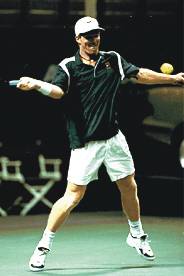<% ns_puts [mkm_getnavbar] %>
Mens Doubles - Return of Serve
by Jim McLennan
Sybase Open,
San Jose Arena, February 7 - 13
Professional tennis - is it sport, entertainment, is it about athleticism or celebrity? Certainly it is any of these to any number of spectators, but the impression grows stronger that only a few of the leading players can turn a match into an entertaining spectacle. And while the level of play is high, the athletes superb, and the shot making thunderous, there still is the question of fan involvement in matches, at least it’s true with this fan here.

Courier favored power over placement but could not buy a return when it counted. |
That said, a thoroughly entertaining first round doubles match featuring Luke and Murphy Jensen against Jonathon Stark and Jim Courier captivated the audience. The Jensen’s prevailed 7-6, 6-7, 7-6, with both teams holding match points in the third set tiebreaker. Riveting stuff, with touch, rat-a-tat exchanges, and large doses of personality (Jensens) enlivening the contest. But to the nuts and bolts of the match, the service returns were in the main abominable. Hideous. No one wants to return the ball low to set up a partner, rather the preferred play appeared to be the blistering 100 mile per hour return, attempting to win the point with one swing of the racquet.
Fellows,
doubles is about teamwork. In that light, Murphy was the most effective,
dipping his returns low and usually off pace, enabling Luke to poach with
abandon. Contrast to Courier and Stark, who appeared to play singles in
their return capacities, favoring power to placement, force to guile, and
in the crucial third set neither could buy a return.
In the old days (and my younger teaching associates howl with laughter at this phrase) Tom Stow encouraged his doubles players to “never miss a return” in a game, if not a set or a match. In short, error free service returns. And how was this done - by borrowing pace, using the serve’s incoming momentum, and blocking the ball low. It’s done using simple grips (eastern or continental), instant preparation, and the briefest, most economical of backswings.

McEnroe preferred artistry over brute force |
Try
to recall the greatest doubles player of the modern age - John McEnroe who
used simple preparation, deflecting rather than crushing the ball, taking
the return early and coming in quickly behind it. McEnroe played doubles
as it was meant to be played. Unfortunately we see less and less of this
in the modern game.
I read somewhere that Vince McMahon of the World Wrestling Federation may open a football league, and the question is whether the games will be as scripted as the wrestling is. If so, perhaps he might also create a tennis tournament, and script this “old” style of play. I bet the turnstiles will be flooded.
Last Updated 9/1/98. To contact us, please email to: webmaster@tennisone.com
TennisONE is a registered trademark of TennisONE and SportsWeb ONE; Copyright 1995. All rights reserved.

